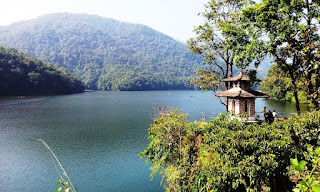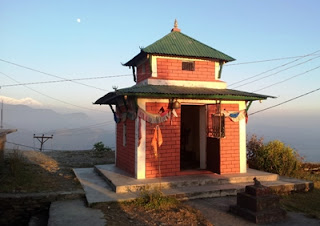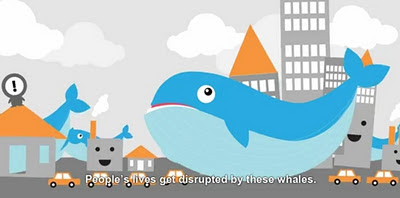[This story is continued from the first part in a series about 10 days of Noble Silence at Vipassana meditation in Kathmandu, Nepal. When we left off I had thought of a joke that I could not get out of my mind but wanted to remember somehow.]
Once every other day there is a brief opportunity to question the teacher about the practical (i.e. non-philosophical) aspects of the meditation. When I asked what I should do if there was something I wanted to remember he replied "Put it out of our mind, forget it." Could I write it down? "No, that would be outward communication and you need to focus on your individual experience. Maintain complete Noble Silence."
You also have to know my memory is shockingly bad. I was tested at sixteen and could not repeat back three numbers in reverse order (e.g. 714... 417). Most people can do five or six numbers. The tester said "Really?... You understand the instructions, right?" The only way I would be able to remember this joke would be endless repetition over the coming eight days.
On an impulse on Day Three I rationalized that I should write down one word only, and that would summarize the whole joke. I would see the word later and remember the rest. However, within minutes of putting down the paper I was cursed by another, less funny and completely inappropriate not-safe-for-work joke. Would I have to write this down too? Or would it be stuck cycling in my head for days? The joke became lame quickly. Out of fear of getting even more unfunnier jokes stuck in my head (a la the Magic Brooms of Fantasia endlessly splitting), I decided not to write down anything more and instead take the teacher's advice to clear my mind.
What was the one word I wrote down?
Proposing.
Frustrating, my plan didn't work. I am not sure if it was a marriage proposal joke (I have done such a joke and it ended really really badly, I do not recommend...). Or was the joke about scientific proposals (e.g. "my project proposal is still with the funding committee"). Maybe it is about forecasting; US river forecasters have different stages in the forecast creation process, from "raw model output", to "preferred", "preliminary", "proposed" and through to "published". So, just like how we know the Answer to Life, the Universe, and Everything but not the question, we know only the punchline to the funniest joke ever told.
Along with Noble Silence there is strict separation of the sexes. My wife attempted to slip me messages by leaving things in my shoes during the evening lectures. It was sweet, but it broke Noble Silence so I was not quite sure what to do. The rules were there not to be mean or oppressive, but were designed for the student to get the most out of the program.
I was torn... My problem with meditation (and life in general I suppose) is that I never know if I am suffering enough. But is the point to be totally miserable and not have any fun, just so you can respect the rules? I sought the advice of the assistants figuring that they would know the best thing to do.
Well! Something got lost in the translation when the assistant talked to the male teacher and he talked to the female "warden." Kitty got assigned a personal guard that would shadow her all the time and scold her when she got out of line. It is hard enough to suffer in silence, but this made it nearly unbearable for her. Kitty nicknamed her guard "Sourpuss".
Part way through a particularly grueling meditation session, Kitty stepped outside the hall for a rest. Everyone is allowed five minutes to go out to the bathroom or get a glass of water or some such, but otherwise attendance in the hall during sessions is mandatory.
After leaving the hall Kitty saw a wild monkey sitting in the sun eating a papad (thin crispy fried bread) that looked like a giant cookie. He had stolen it from the kitchen. It was a magical moment. I too adored the monkeys and spent my breaks wandering the grounds trying to find them (this was another philosophical crisis... if I was meant to get rid of both aversion and cravings, what should I do if I craved seeing monkeys?)
Immediately Sourpuss stormed on the scene and scolded "Miss! Meditation time!" and pointed back towards the hall.
Kitty protested "I am allowed my five minutes!" to which Sourpuss reluctantly agreed. When she saw what Kitty was looking at, Sourpuss stood between Kitty and the monkey, blocking her view.
Of course, I only heard about what happened to her after the program ended. So I hope this can be my very public apology? Forgive me?
I do remember one joke I thought of. The Vipassana Center has a regular 10 day program for new and returning students but there are also longer programs, 30, 45, 60 days or more in total silence. There was one "perpetual" course where, one day a year, the student would be allowed to speak one sentence.
After the end of the first year, the students appeared before the teacher. He said to one student, "You may now speak"... After a long pause, the student replied "The toilet in my cell is broken" [Actually, that was my first crisis after Noble Silence started, but that's another story.]
"Mmn, I understand." the teacher answered. "Namaste."
The next year, the same student appeared before the teacher and said "The food here is terrible."
"Mmn, yes, I see...Go in peace."
The third year, again the student said "My cell is too cold".
"Continue on your path and be very vigilant, very attentive..."
"Actually, I quit."
"Thank goodness!" the teacher replied, "You've done nothing but complain since you got here."
Once every other day there is a brief opportunity to question the teacher about the practical (i.e. non-philosophical) aspects of the meditation. When I asked what I should do if there was something I wanted to remember he replied "Put it out of our mind, forget it." Could I write it down? "No, that would be outward communication and you need to focus on your individual experience. Maintain complete Noble Silence."
You also have to know my memory is shockingly bad. I was tested at sixteen and could not repeat back three numbers in reverse order (e.g. 714... 417). Most people can do five or six numbers. The tester said "Really?... You understand the instructions, right?" The only way I would be able to remember this joke would be endless repetition over the coming eight days.
On an impulse on Day Three I rationalized that I should write down one word only, and that would summarize the whole joke. I would see the word later and remember the rest. However, within minutes of putting down the paper I was cursed by another, less funny and completely inappropriate not-safe-for-work joke. Would I have to write this down too? Or would it be stuck cycling in my head for days? The joke became lame quickly. Out of fear of getting even more unfunnier jokes stuck in my head (a la the Magic Brooms of Fantasia endlessly splitting), I decided not to write down anything more and instead take the teacher's advice to clear my mind.
 |
| Mickey thought it was a good idea too, until it all went pear shaped. |
Proposing.
Frustrating, my plan didn't work. I am not sure if it was a marriage proposal joke (I have done such a joke and it ended really really badly, I do not recommend...). Or was the joke about scientific proposals (e.g. "my project proposal is still with the funding committee"). Maybe it is about forecasting; US river forecasters have different stages in the forecast creation process, from "raw model output", to "preferred", "preliminary", "proposed" and through to "published". So, just like how we know the Answer to Life, the Universe, and Everything but not the question, we know only the punchline to the funniest joke ever told.
Along with Noble Silence there is strict separation of the sexes. My wife attempted to slip me messages by leaving things in my shoes during the evening lectures. It was sweet, but it broke Noble Silence so I was not quite sure what to do. The rules were there not to be mean or oppressive, but were designed for the student to get the most out of the program.
I was torn... My problem with meditation (and life in general I suppose) is that I never know if I am suffering enough. But is the point to be totally miserable and not have any fun, just so you can respect the rules? I sought the advice of the assistants figuring that they would know the best thing to do.
Well! Something got lost in the translation when the assistant talked to the male teacher and he talked to the female "warden." Kitty got assigned a personal guard that would shadow her all the time and scold her when she got out of line. It is hard enough to suffer in silence, but this made it nearly unbearable for her. Kitty nicknamed her guard "Sourpuss".
| Sourpuss and Kitty, wearing all her shirts and socks. They were friends by the end. |
After leaving the hall Kitty saw a wild monkey sitting in the sun eating a papad (thin crispy fried bread) that looked like a giant cookie. He had stolen it from the kitchen. It was a magical moment. I too adored the monkeys and spent my breaks wandering the grounds trying to find them (this was another philosophical crisis... if I was meant to get rid of both aversion and cravings, what should I do if I craved seeing monkeys?)
Immediately Sourpuss stormed on the scene and scolded "Miss! Meditation time!" and pointed back towards the hall.
Kitty protested "I am allowed my five minutes!" to which Sourpuss reluctantly agreed. When she saw what Kitty was looking at, Sourpuss stood between Kitty and the monkey, blocking her view.
Of course, I only heard about what happened to her after the program ended. So I hope this can be my very public apology? Forgive me?
I do remember one joke I thought of. The Vipassana Center has a regular 10 day program for new and returning students but there are also longer programs, 30, 45, 60 days or more in total silence. There was one "perpetual" course where, one day a year, the student would be allowed to speak one sentence.
After the end of the first year, the students appeared before the teacher. He said to one student, "You may now speak"... After a long pause, the student replied "The toilet in my cell is broken" [Actually, that was my first crisis after Noble Silence started, but that's another story.]
"Mmn, I understand." the teacher answered. "Namaste."
The next year, the same student appeared before the teacher and said "The food here is terrible."
"Mmn, yes, I see...Go in peace."
The third year, again the student said "My cell is too cold".
"Continue on your path and be very vigilant, very attentive..."
"Actually, I quit."
"Thank goodness!" the teacher replied, "You've done nothing but complain since you got here."
 |
| Liberation day at the front gate |











































